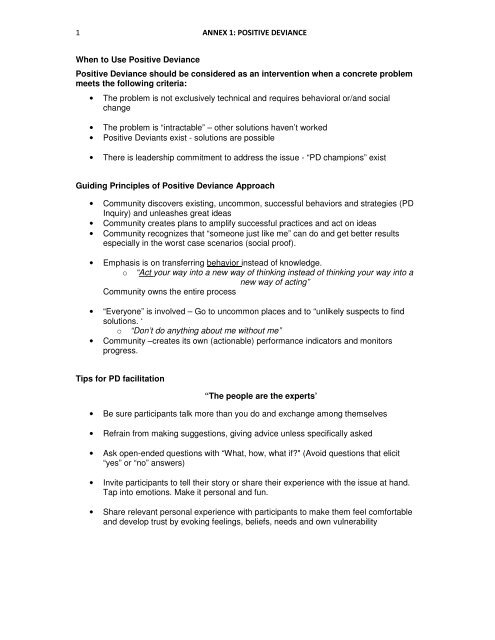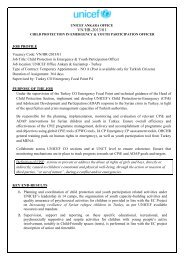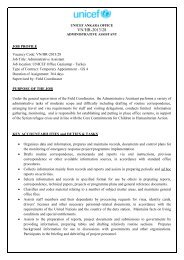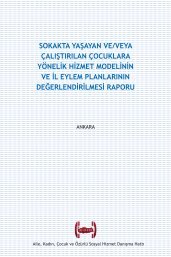1 ANNEX 1: POSITIVE DEVIANCE When to Use Positive Deviance ...
1 ANNEX 1: POSITIVE DEVIANCE When to Use Positive Deviance ...
1 ANNEX 1: POSITIVE DEVIANCE When to Use Positive Deviance ...
You also want an ePaper? Increase the reach of your titles
YUMPU automatically turns print PDFs into web optimized ePapers that Google loves.
1 <strong>ANNEX</strong> 1: <strong>POSITIVE</strong> <strong>DEVIANCE</strong><strong>When</strong> <strong>to</strong> <strong>Use</strong> <strong>Positive</strong> <strong>Deviance</strong><strong>Positive</strong> <strong>Deviance</strong> should be considered as an intervention when a concrete problemmeets the following criteria:• The problem is not exclusively technical and requires behavioral or/and socialchange• The problem is “intractable” – other solutions haven’t worked• <strong>Positive</strong> Deviants exist - solutions are possible• There is leadership commitment <strong>to</strong> address the issue - “PD champions” existGuiding Principles of <strong>Positive</strong> <strong>Deviance</strong> Approach• Community discovers existing, uncommon, successful behaviors and strategies (PDInquiry) and unleashes great ideas• Community creates plans <strong>to</strong> amplify successful practices and act on ideas• Community recognizes that “someone just like me” can do and get better resultsespecially in the worst case scenarios (social proof).• Emphasis is on transferring behavior instead of knowledge.o “Act your way in<strong>to</strong> a new way of thinking instead of thinking your way in<strong>to</strong> anew way of acting”Community owns the entire process• “Everyone” is involved – Go <strong>to</strong> uncommon places and <strong>to</strong> “unlikely suspects <strong>to</strong> findsolutions. ‘o “Don’t do anything about me without me”• Community –creates its own (actionable) performance indica<strong>to</strong>rs and moni<strong>to</strong>rsprogress.Tips for PD facilitation“The people are the experts’• Be sure participants talk more than you do and exchange among themselves• Refrain from making suggestions, giving advice unless specifically asked• Ask open-ended questions with “What, how, what if?" (Avoid questions that elicit“yes” or “no” answers)• Invite participants <strong>to</strong> tell their s<strong>to</strong>ry or share their experience with the issue at hand.Tap in<strong>to</strong> emotions. Make it personal and fun.• Share relevant personal experience with participants <strong>to</strong> make them feel comfortableand develop trust by evoking feelings, beliefs, needs and own vulnerability
2 <strong>ANNEX</strong> 1: <strong>POSITIVE</strong> <strong>DEVIANCE</strong><strong>Use</strong>ful Definitions for the <strong>Positive</strong> <strong>Deviance</strong> course for practitionersPD Concept:<strong>Positive</strong> <strong>Deviance</strong> is based on the observation that in every community or organization, thereare a few individuals or groups who have overcome or prevented a pervading problem.PD Approach:A strength-based development method that enables a community or organization <strong>to</strong> bringabout sustainable behavior and social change through identification and amplification ofexisting solutions from within.PD Individual or Group:A person or group whose special or uncommon behaviors and strategies enablehim/her/them <strong>to</strong> overcome a problem without special resources and facing similar barriersand challenges as their peers. A person is called “PD” only in the context of a specificproblem.PD Design or Methodology:The PD design is made up of four steps: Define the problem and desired outcome,Determine the presence of PD individuals or groups, Discover uncommon but successfulbehaviors and strategies through a PD inquiry, Design activities that allow other communitymembers <strong>to</strong> practice these identified behaviors or strategies. These steps serve as aniterative roadmap <strong>to</strong> apply the PD approach.PD Inquiry: (Step 3 Discover)A <strong>to</strong>ol <strong>to</strong> enable community members <strong>to</strong> discover demonstrably successful behaviors andstrategies among their midst.PD Process:The process refers <strong>to</strong> the skillful facilitation and use of experiential learning methods used <strong>to</strong>apply the 4 steps of the PD design. This process results in as<strong>to</strong>unding and lasting success insolving the problem via community mobilization and ownership of solutions and subsequentinitiatives.Reference: Basic Guide <strong>to</strong> the <strong>Positive</strong> <strong>Deviance</strong> (PD) Approach, Developed by thePDI (<strong>Positive</strong> <strong>Deviance</strong> Initiative), May 2009
















